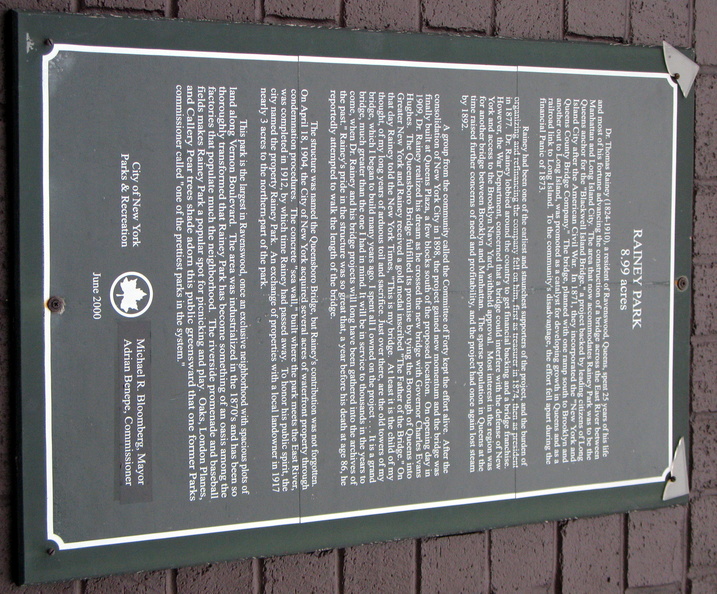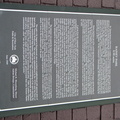
Dr. Thomas Rainey (1824-1910), a resident of Ravenswood, Queens, spent 25 years of his life and most of his fortune advancing the construction of a bridge across the East River between Manhattan and Long Island City. The area that now accommodates Rainey Park was to be the Queens anchor for the “Blackwell Island Bridge,” a project backed by leading citizens of Long Island City after the American Civil War. In 1871, they incorporated the “New York and Queens County Bridge Company.” The bridge, planned with one ramp south to Brooklyn and another out to Long Island, was promoted as a catalyst for developing growth in Queens and as a railroad link to Long Island. To the community’s disadvantage, the effort fell apart during the financial Panic of 1873.
Rainey had been one of the earliest and staunchest supporters of the project, and the burden of organizing and refinancing the company fell on him, first as treasurer in 1874, then as president in 1877. Dr. Rainey lobbied around the country to get financial backing and a bridge franchise. However, the War Department, concerned that a bridge could interfere with the defense of New York and access to the Brooklyn Navy Yard, withheld approval. Most interest in the region was for another bridge between Brooklyn and Manhattan. The sparse population in Queens at the time raised further concerns of need and profitability, and the project had once again lost steam by 1892.
A group from the community called the Committee of Forty kept the effort alive. After the consolidation of New York City in 1898, the project gained new momentum and the bridge was finally built at Queens Plaza, a few blocks south of the proposed location. On opening day in 1909, Dr. Rainey realized his dream as he crossed the new bridge with Governor Charles Evans Hughes. The Queensboro Bridge fulfilled its promise by tying the Borough of Queens into Greater New York and Rainey received a gold medal inscribed “The Father of the Bridge.” On that day Rainey told the New York Times, “This is my bridge. At least it is the child of my thought, of my long years of arduous toil and sacrifice. Just over there, are the old towers of my bridge, which I began to build many years ago. I spent all I owned on the project . . . It is a grand bridge, much greater than the one I had in mind. It will be in service to thousands in the years to come, when Dr. Rainey and his bridge projects will long have been gathered into the archives of the past.” Rainey’s pride in the structure was so great that, a year before his death at age 86, he reportedly attempted to walk the length of the bridge.
The structure was named the Queensboro Bridge, but Rainey’s contribution was not forgotten. On April 18, 1904, the City of New York acquired several acres of waterfront property through condemnation procedures. The concrete “sea wall,” built where the park meets the East River, was completed in 1912, by which time Rainey had passed away. To honor his public spirit, the city named the property Rainey Park. An exchange of properties with a local landowner in 1917 nearly 3 acres to the northern part of the park.
This park is the largest in Ravenswood, once an exclusive neighborhood with spacious plots of land along Vernon Boulevard. The area was industrialized in the 1870’s and has been so thoroughly transformed that Rainey Park has become something of an oasis among the factories that populate much the neighborhood. The riverside promenade and baseball fields makes Rainey Park a popular spot for picnicking and play. Oaks, London Planes, and Callery Pear trees shade adorn this public greensward that one former Parks commissioner called “one of the prettiest parks in the system.”
- Created on
- Saturday 15 November 2008

0 comments